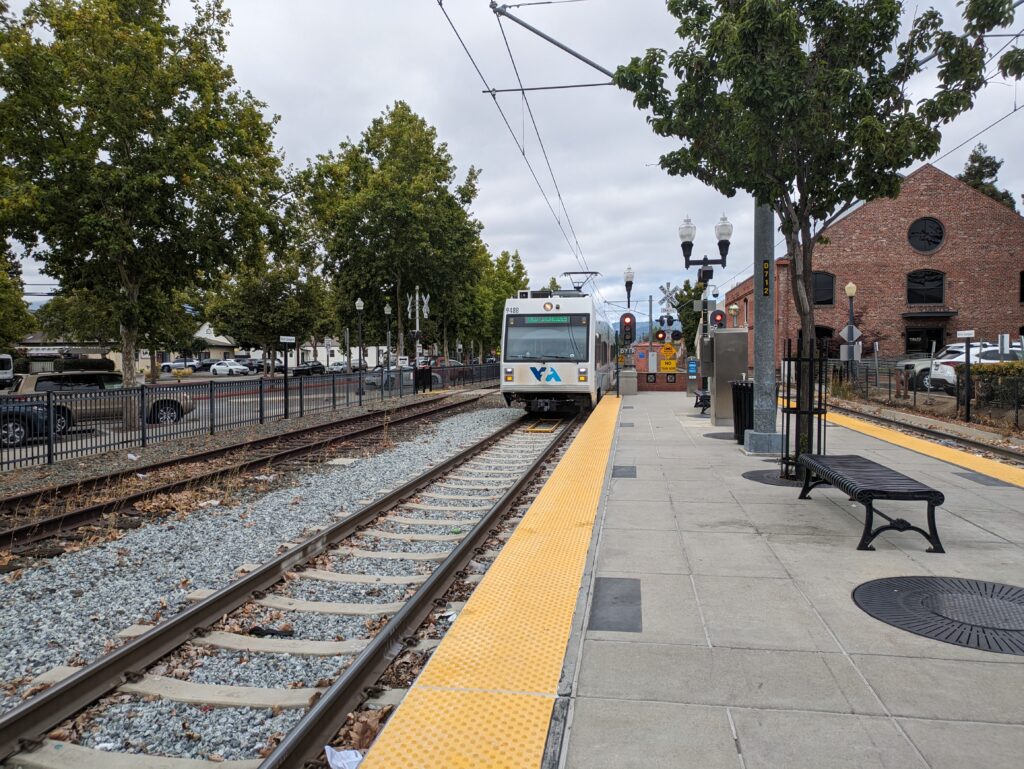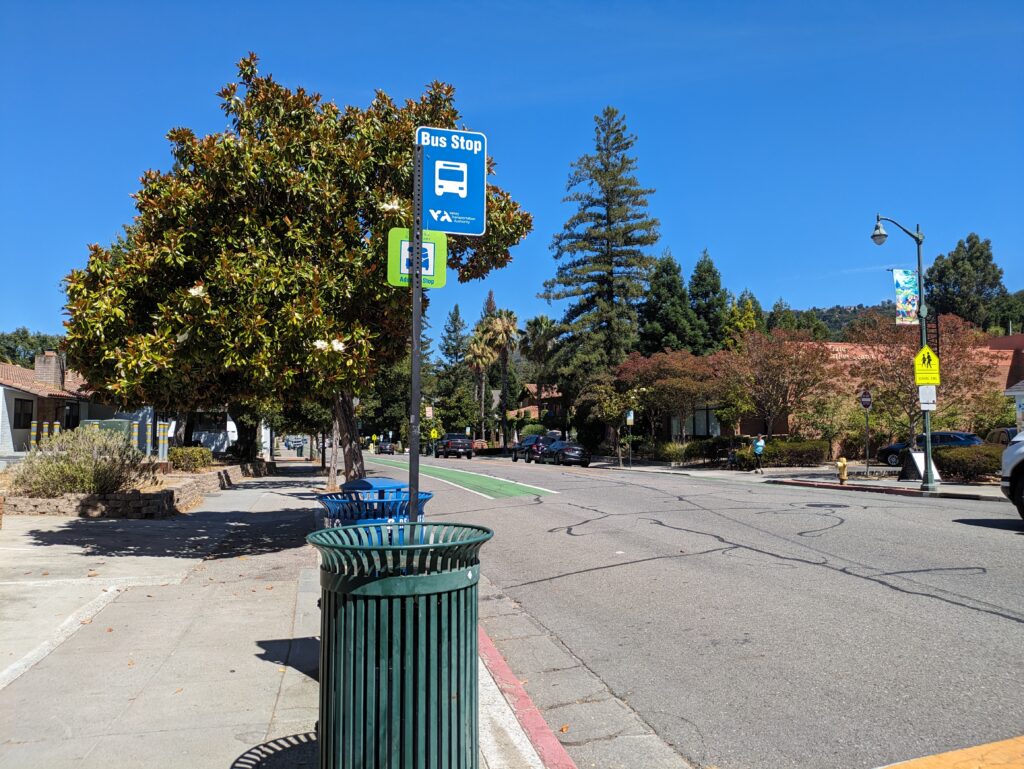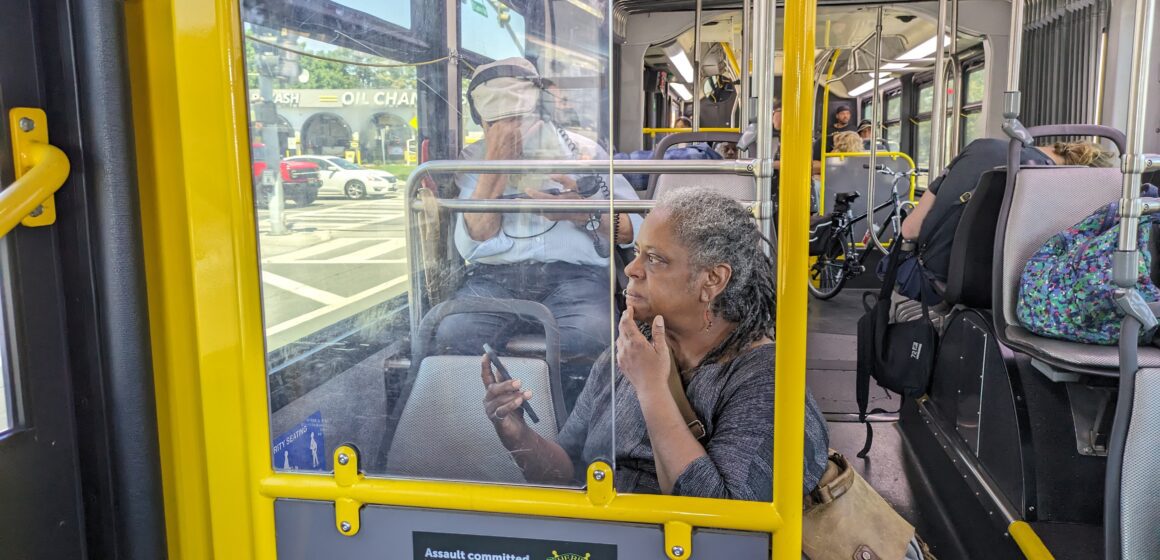Los Gatos resident Kylie Clark wants to be able to rely on public transportation for VTA Citizens Advisory Committee meetings where she serves. But to do that would take her up to two hours each way — time she can’t spare, especially when it takes up to 30 minutes to drive.
Clark is one of the residents stuck with a less frequent and sometimes unreliable public transportation system in Los Gatos and Cupertino, where transit riders have to rely solely on the buses, since there’s no light rail. Transit advocates, including Clark, said the service is inequitable across the sprawling West Valley for residents dependent on public transportation.
“The lack of focus on the West Valley is making it so that it is more likely to stay in an area that’s rather exclusive to people who aren’t more affluent,” Clark told San José Spotlight. “If you end up having car troubles that you can’t afford to fix, you end up high and dry or having a lower quality of life.”
Los Gatos has one bus route that runs directly through town, and two near the border, according to VTA routes. Riders told San José Spotlight even though it’s supposed to come every roughly 25 to 55 minutes, it’s sometimes late or doesn’t show at all. Cupertino has eight routes with wait times varying from 15 minutes to just more than an hour. The city has frequent and rapid lines, but some routes provide less service to Cupertino than other cities.
Campbell is the one West Valley city that figured it out decades ago when it opened the Vasona Light Rail line with three city stops and an endpoint in downtown San Jose. The small city has about seven bus routes, according to VTA’s website.
Campbell Mayor Sergio Lopez, who also serves as chair of the VTA board of directors, grew up taking the bus. He said previous VTA board members had to balance between increasing service in lower income areas, like East San Jose, or expanding county coverage into areas including the West Valley. They chose increased service.
“I see both the vast potential of what happens when we get it right,” Lopez told San José Spotlight.

A VTA spokesperson said many factors contribute to the transit agency’s routes, including its operating budget, community input, land uses, street grid orientation and transportation infrastructure. The spokesperson said while some of those issues fall under VTA’s purview, many require county and city collaboration.
“The frequency varies throughout the county — higher populations and more densified areas tend to drive a higher demand for transit, and allow VTA to run productive routes that carry as many riders with the finite resources available,” the spokesperson told San José Spotlight.
Effects on riders
Brenda Bell Brown, who’s on VTA’s Community Based-Organizations Working Group, can’t afford to replace her car, which was totaled in 2023. She lives in San Jose, but travels by bus to hunger and homelessness nonprofit West Valley Community Services in Cupertino for groceries. It takes her about 40 minutes one-way on a good day compared to 15 minutes driving.
Brown, 66, always plans for a three-hour time buffer because she has to take multiple buses to get to most destinations, even though she lives near a bus stop. She said there are times when she’s been waiting and the buses are late or fail to show up.
“I have done it when I have been pressed for time — there’s (no) method in (that) madness,” she told San José Spotlight. “You just do not do it.”
Sujatha Venkatraman, executive director of West Valley Community Services, said some of the travel times for clients can take up to four hours one-way by bus. She said because the buses don’t drive on smaller streets, there’s a lack of connectivity that programs like RYDE partially address. The service offers affordable rides to older adults in the West Valley. Cupertino also has Silicon Valley Hopper, an affordable micro-transit service that’s limited to certain cities.
“They cannot rely on public transportation because of the infrequency … and then they have already exhausted all their friends and family’s help,” Venkatraman told San José Spotlight. “That was the reason we started looking at alternatives, because it’s so hard when you don’t have that money to spend.”

Ridership and investment
The West Valley’s low ridership makes it harder for VTA to justify more investment in the region, transit advocates said. It also has some of the wealthiest municipalities in Santa Clara County — Saratoga, Monte Sereno, Los Gatos and Cupertino.
Los Gatos, population 33,500, had an average of 264 weekday boardings last October, according to VTA data. Weekday boarding in Cupertino, population 60,400, totaled 2,774 last October. In comparison, Campbell, population 44,000, saw a total of 2,544 boardings last October.
Clark has seen the low numbers in the West Valley firsthand.
“It kind of turns into a self-fulfilling prophecy where, because the transit isn’t good, people aren’t using it,” Clark said. “(VTA) can’t justify improving it, if that’s the paradigm that you’re working with.”
The VTA spokesperson said the transit agency has to work within its budget while balancing the county’s varying needs. VTA anticipates a multimillion-dollar deficit in upcoming fiscal years.
“There are routes that also exist to serve important community destinations and critical services regardless of how much ridership they’re expected to attract,” the spokesperson said. “While these coverage-based routes may not operate as frequently, they serve their purpose of connecting people to where they need, and that goal is just as important.”
Clark said while the gaps are frustrating, she’s optimistic she’ll be able to take the bus easily to VTA meetings one day. Los Gatos residents on the Complete Streets and Transportation Commission recently introduced the idea of a free bus pass pilot program for students, school staff and older adults to boost ridership and promote investment.
“The problem sounds so ridiculous,” Clark said. “At face value, it’s like, ‘How do we have this problem in the most affluent part of California and maybe of our country?’ But then, when you look at it and actually question, ‘How do we spend the money? How do we get that money?’ It is harder.”
Contact Annalise Freimarck at [email protected] or follow @annalise_ellen on X.



Leave a Reply
You must be logged in to post a comment.